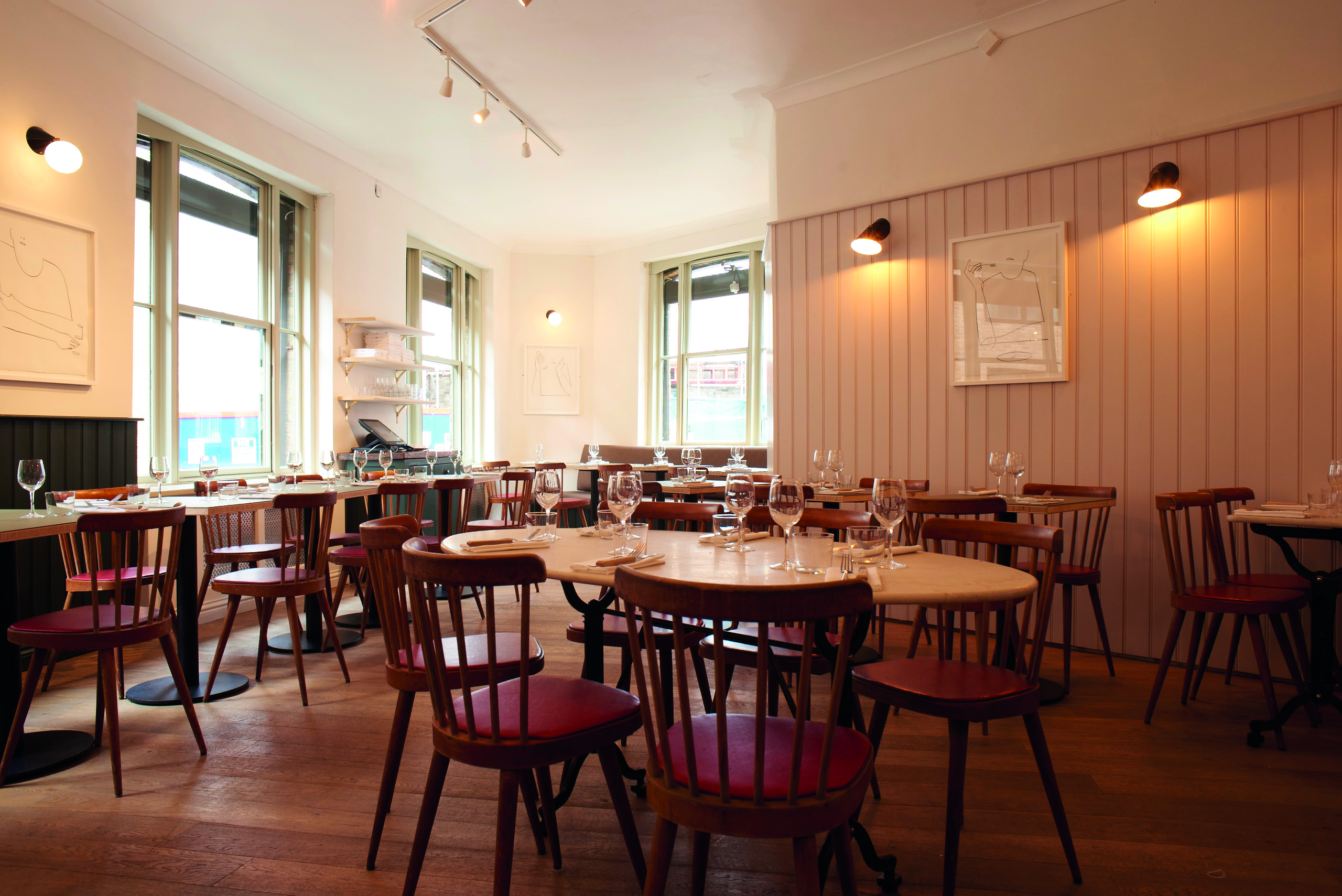Book Extract: Tom Kerridge's Proper Pub Food
To accompany his BBC2 TV series Tom Kerridge's Proper Pub Food, the two-Michelin-starred chef has written a book revealing his secrets for making food ‘truly amazing'. Among the 100 recipes are perfected dishes from his childhood as well as those served at his pub, the Hand & Flowers, in Marlow. In this extract, we feature three of the best. Images by Cristian Barnett
SMOKED HADDOCK, PARMESAN AND CREME FRAICHE OMELETTE
We have had a version of omelette Arnold Bennett in one form or another on the menu at the Hand & Flowers since we opened in 2005.
If I am ever in the pub, I always order this as a starter. This is a larger version, however, intended for sticking in the middle of the table for everybody to dig into and help themselves. At the pub we use hollandaise sauce, but here crème fraîche makes the recipe a little more accessible and a lot quicker to knock up for a first course or a lunch. I specify free-range eggs here because this really is a dish that is all about the eggs.
Ingredients
(Serves 6-8)
600ml milk
60g butter
30g plain white flour
10 large free-range eggs
150g Parmesan cheese, freshly grated
3tbs finely chopped chives
150g crème fraîche
2 extra large free-range egg yolks
Salt and pepper, to taste
Method
Put the milk in a large saucepan over a high heat and bring to the boil. Place the smoked haddock into the milk and turn off the heat. Place a lid on the pan and leave the smoked haddock to gently poach in the milk for eight to 10 minutes until the fish is cooked through and the flesh flakes easily.
Remove the haddock from the pan and reserve the poaching milk. When the smoked haddock is cool enough to handle, remove all bones and the skin and discard. Flake the flesh into large pieces and leave to one side until needed.
Melt 30g butter in a saucepan over a medium heat. Add the flour and stir for two to three minutes to cook out the raw flavour. Slowly strain the poaching milk through a fine sieve onto the flour and butter, stirring to make a smooth sauce. Press a piece of clingfilm on the surface to prevent a skin forming and leave to one side until needed.
Preheat the grill to high if you donât have a blowtorch. Whisk the 10 whole eggs in a large bowl and season. Melt the remaining 30g butter in a 30cm non-stick frying pan with a flameproof handle over a low heat. Pour in the whisked eggs and cook the omelette nice and slowly for four to five minutes until it is just set. Remove the pan from the heat and cover the surface with the Parmesan. Add the chives and then place the flaked smoked haddock over the top.
Mix the crème fraîche, extra egg yolks and six tablespoons of the haddock-flavoured white sauce together. Spoon this mixture over the top of the omelette, then use a blowtorch to make a lovely glaze, or cook under a preheated grill. Serve in the middle of the table for everybody to help themselves.

I love traditional pork pies â" they are one of the great British classics. And when you add a â¨dollop of hot, sweet piccalilli everything feels right in the world. I try to recreate familiar British foods at my pub, but take them to a higher level. Just try and stop yourself from smiling when you try this lush pork pie.
Ingredients
(Serves 16)
1kg boneless pork shoulder, skinned and diced
250g smoked streaky bacon in one piece, diced
250g pork belly, skinned and minced
3tbs chopped sage leaves
2tbs thyme leaves
1tsp cayenne pepper
1tsp ground mace
1tsp cracked black pepper
1tsp cracked white pepper
1tsp salt
2 eggs beaten with a splash of double cream â¨to glaze
300ml ham stock or chicken stock
3 leaves of gelatine
For the hot-water crust pastry
550g plain white flour, plus extra for rolling
11/2 tsp salt
100g butter, cubed
100g lard, cubed, plus extra for greasing the tin
200ml water
2 eggs, beaten
For the piccalilli
150g French beans, topped and tailed and cut into 1cm dice
4 shallots, finely chopped
2 small onions, finely chopped
1/2 large head of cauliflower, broken into small florets
1 small cucumber, deseeded and cut into â¨1cm dice
3tbs sea salt flakes
300ml white wine vinegar
125ml malt vinegar
1/4 tsp dried chilli flakes
350g caster sugar
2tbs English mustard powder
2tbs ground turmeric
11/2 tbs cornflour
Method
At least 24 hours in advance, start the piccalilli. Mix the French beans, shallots, onions, cauliflower, cucumber and sea salt together in a large non-metallic bowl. Cover the bowl with clingfilm and leave to stand at room temperature for 24 hours.
Meanwhile, put the white wine vinegar, malt vinegar and chilli flakes in a saucepan over a high heat and bring to the boil. Remove the pan from the heat and leave mix on one side to cool.
After the vegetables have been in the fridge for 24 hours, rinse them well to remove the salt, then return them to the washed bowl.
Combine the caster sugar, mustard powder, turmeric and cornflour in a bowl. Stir in a little of the vinegar mixture until smooth, then add this thin paste to the remaining vinegar mixture in the pan. Bring to just below the boil, stirring until it thickens slightly. Pour it over the vegetables and blend together well. Leave to one side to cool completely.
To make the hot-water crust pastry, mix the flour and salt together in a large bowl and make a well in the centre. Melt the butter and lard with the water in a saucepan over a medium heat. Pour this melted fat and the eggs into the well and mix with a wooden spoon to form a dough. Use your hand to knead the dough around the bowl until it is smooth and silky. Cover the bowl with clingfilm and leave the dough to rest for an hour, or until the dough becomes elastic and easy to work.
Meanwhile, make the filling. Mix the pork shoulder, bacon, pork belly, sage and thyme leaves, cayenne, mace, the black and white peppers and the salt together in a large bowl. Leave to one side until needed.
Preheat the oven to 180°C/gas mark 4. Generously grease a deep 25cm springform cake tin with lard. Cut off one-quarter of the dough, wrap in clingfilm and leave to one side to use later for the pie lid.
Roll the remaining dough out on a lightly floured surface into a 45cm circle about 1cm thick. Drape the pastry over the rolling pin and unroll it over the pan, then gently ease it down into the pan. Press it down onto the base, but leave the overhang.
Fill the pastry case with the filling, pressing it down against the base and side. Roll out the remaining pastry into a 25cm circle 1cm thick. Place it on top of the pie. Dampen the underneath edge and press to seal with the overhang. Use a fork to crimp all around the edge, then cut a steam hole in the centre.
Place the pie on a baking sheet and bake for 30 minutes. Reduce the heat to 160°C/gas mark 3 and bake for a further hour and a quarter. Remove the pie from the oven and brush the pastry with the egg glaze, then return it to the oven and bake for a further 15 minutes, or until the pastry is golden brown and the juices run clear when you stick a skewer into the filling. Transfer the pie to a wire rack and leave to cool completely.
When the pie is cool, warm the stock in a saucepan over a medium heat. Do not let it boil. Soak the gelatine leaves in cold water for about five minutes until softened. Squeeze out the water, then add them to the warm stock and stir until the gelatine has dissolved. Pour the stock into the pie through the steam hole, then leave the gelatine to cool and set. Serve the pie cut into wedges with piccalilli.

Creamy junket is an English classic you donât often see any more, but junkets are so easy to make. I serve this one with macaroons, sandwiched with a rich coffee ganache to give a little texture and depth. I sometimes serve these with crème fraîche on the side, too. Leftover macaroons will keep in a sealed container in the fridge for a few days.
Ingredients
(Serves 4 â" makes about 40 filled macaroons)
600ml full-fat milk
50g caster sugar
1tsp rennet
2tsp dark rum
1 nutmeg, to decorate
For the coffee macaroons
75g ground almonds
75g icing sugar
1tsp ground instant coffee
80g egg whites (approximately 3 eggsâ worth)
125g caster sugar
30ml water
For the coffee ganache 100g milk chocolate, broken
100g double cream
1tsp instant coffee
Method
To make the coffee meringues, line two baking sheets with baking parchment and leave to one side. Sift the ground almonds, icing sugar and instant coffee through a fine sieve into a bowl. Pour half of the egg whites on top and just fold together gently, then set aside.
Place the sugar and water in a saucepan over a high heat, stirring to dissolve the sugar, and boil until it reaches to 118°C on an instant-read thermometer. Place the remaining egg whites in the bowl of a freestanding mixer and beat until soft peaks form.
With the mixer still running, slowly pour in the hot sugar mix and continue mixing until the meringue is cool. Fold the cooled meringue into the almond and coffee mix, trying not to knock too much air out. Put the mix into a piping bag with a plain nozzle and pipe blobs the size of 10p pieces onto the baking sheet. Leave at room temperature for 30 minutes to let the mix form a skin.
Meanwhile, preheat the oven to 150°C/gas mark 2. After the meringues have formed their skin, put the baking sheet in the oven and bake for 10 to 15 minutes until they have a crisp shell on the outside but are still sticky in the middle. Remove the meringues from the baking sheet and cool them on a wire rack. At this stage you can freeze them for up to a month.
To make the coffee ganache, place the chocolate in a heatproof bowl that fits over a saucepan of simmering water without the bottom of the bowl touching the water and melt, stirring occasionally.
Remove the bowl from the pan and tip out the water. Bring the cream and instant coffee to the boil in the pan, then stir the coffee-flavoured cream into the melted chocolate. Pour the mix into a piping bag and leave to cool to a sticky piping consistency that isnât too runny.
When the meringues are cool, stick them together in pairs, using the coffee ganache. Leave to one side if you are serving soon, or place in the fridge for up to a day.
About two hours before you want to serve, make the junket. Place the milk and sugar in a saucepan over a medium heat, stirring to dissolve the sugar, and heat until it reaches 37°C on an instant-read thermometer.
Pour in the rennet and rum. Pass the junket through a fine sieve into your serving bowls and leave to set at room temperature, which will take about an hour. Freshly grate nutmeg over the tops and put into the fridge for 45 minutes.
Serve the bowls of junket with the macaroons.

















